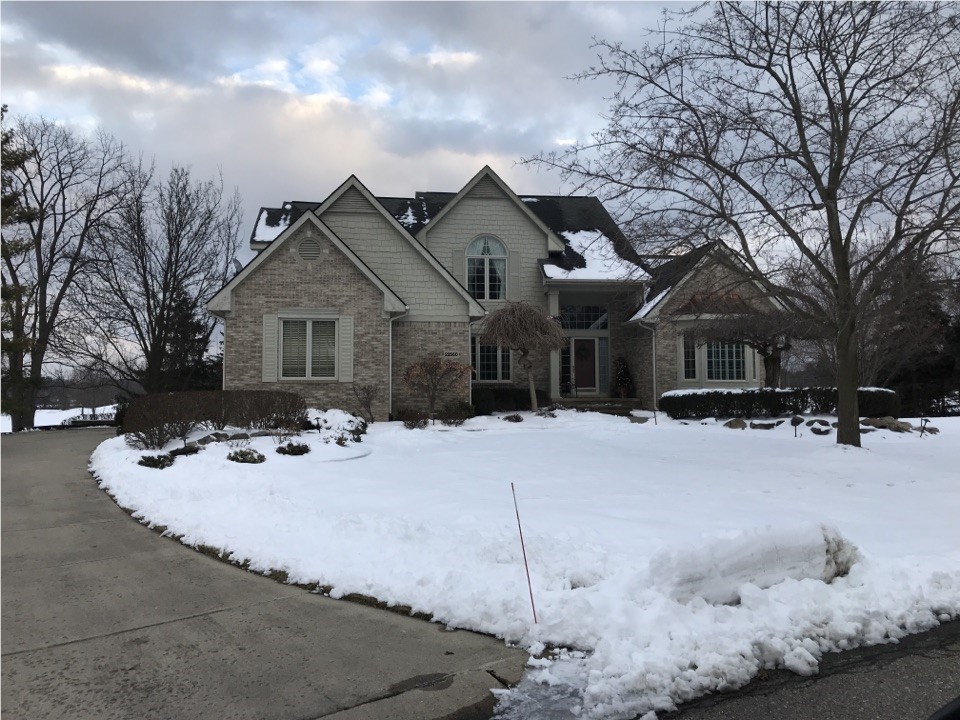
Discovering a winter roof leak is a puzzle that needs immediate attention. It could signify potentially serious problems that require a temporary fix until the weather fully cooperates. The team at Shanco have gathered insights into the possible causes of these chilly season leaks and provided answers to common questions you might have and shared some roof maintenance winter tips.
What Causes Roof Leaks in The Winter
Experiencing concern or stress upon discovering a roof leak is entirely understandable. To embark on a journey toward peace of mind, begin by identifying the source of the leak. Once you've pinpointed it, you can proceed to determine the necessary steps and address the issue. The common winter roof issues typically include:
Formation of Ice Dams: Ice dams form as the snow melts from your roof and then refreezes along the roof's edge, creating a barrier of ice. This process can displace your asphalt shingles, potentially causing water leaks. Furthermore, ice dams can obstruct the effective drainage of melted ice and snow water on your roof. Neglecting to eliminate the ice dam and promote proper water drainage may lead to water damage and leaks.
Attic Condensation: Have you noticed an increase in moisture in your attic during the winter season? This could be because of condensation, a process initiated when warm indoor air ascends into the attic, encounters cooler temperatures, and subsequently condenses.
Now, here's the catch – the lingering excess moisture in your attic could lead to issues. Think potential mold, pesky mildew, and the dreaded leaks. If any of these red flags appear, it's probably a good time to explore the realms of attic ventilation and moisture management. Your home will undoubtedly appreciate the proactive approach!
Bathroom Exhaust Fans: Bathroom exhaust fans are specifically crafted to vent air directly outside. However, if your fan directs air into the attic, it introduces warm and moist air to the attic space, promoting the development of condensation and giving prime conditions for mold growth. If this condensation freezes and then thaws in the attic, it may appear as drips that mimic a roof leak. Even if the leak isn't visible on the exterior walls of your home, it's advisable to inspect the interior walls for potential signs.
Clogged Gutters: When gutters and downspouts get blocked with leaves and debris, it leaves no place for water to flow. Clogged gutters cause melted ice and snow to pool. It’s important to clear your gutters before the winter weather sets in.
Damaged Flashing: Flashing can be susceptible to failure of the course of time. It helps direct water away from leak prone places on the roof. If damaged, it’s an easy place for melted snow and ice to penetrate the roof of your home. Tackle flashing repairs promptly to protect your roof from potential water-related problems.
Damaged Shingles: If your home has endured a winter storm featuring high winds or hail, the culprit behind your leak might be storm damage. Even a small, overlooked breach in your roofing material has the potential to evolve into significant issues, including structural damage.
How to Address a Recently Discovered Leak
If you think there might be a roof leak, the initial step is to reach out to a local roofing company for a professional inspection. Detecting a leak early on not only prevents headaches but also spares you from the complications and higher costs associated with extensive roof repairs. Promptly engaging in a thorough inspection is crucial for maintaining your roof's integrity and preventing potential future problems, especially considering the challenges posed by winter roof leak repair in Winchester, VA.
Can a Roofing Repair Be Done in The Winter?
There's no one-size-fits-all solution to this question or even the question “who do I contact for a roof leak repair in winter?” In some cases, a roofing professional can absolutely provide the necessary service. However, if the weather conditions or the condition of your roof presents substantial hazards for either you or the roofing crew, it might be wise to postpone your roof replacement until spring.
Nevertheless, starting the conversation with a roofer and kicking off the planning process for your roof repair sooner rather than later is a smart decision. Delaying action could potentially lead to more complications, so don't hesitate—get in touch with roofing contractors as soon as possible! While emergency roof repair may not be possible, tarping the area to prevent water penetration is an option.
Stopping Roof Leaks in The Winter Before They Start
The first step to prevent winter roof leaks is to clear your gutters before it gets cold. Proper insulation helps keep your attic temperature moderated. Insufficient insulation could be one of your leaks causing factors.
Take a proactive approach by arranging a professional roofing company to inspect your roof system prior to the winter months. Cold weather roof leak prevention is critical before winter weather sets in.
Furthermore, take notice of tree branches hanging over your home as the limbs are susceptible to snow and ice roof damage. In the instance of an ice storm, the weight of the ice can cause limbs to break and cause damage to your home. Heavy snowfall can cause branches to fall as well. Protect your home by keeping branches trimmed back.
For an additional layer of protection, explore our blog where we discuss ways to prevent ice dams—it can play a crucial role in maintaining a snug and leak-free roof during the frosty season.
Contact the team at Shanco today to discuss winter roof leak solutions and restore your roof to keep your home safe and dry.
Tags
Subscribe to Shanco's Blog


Comments